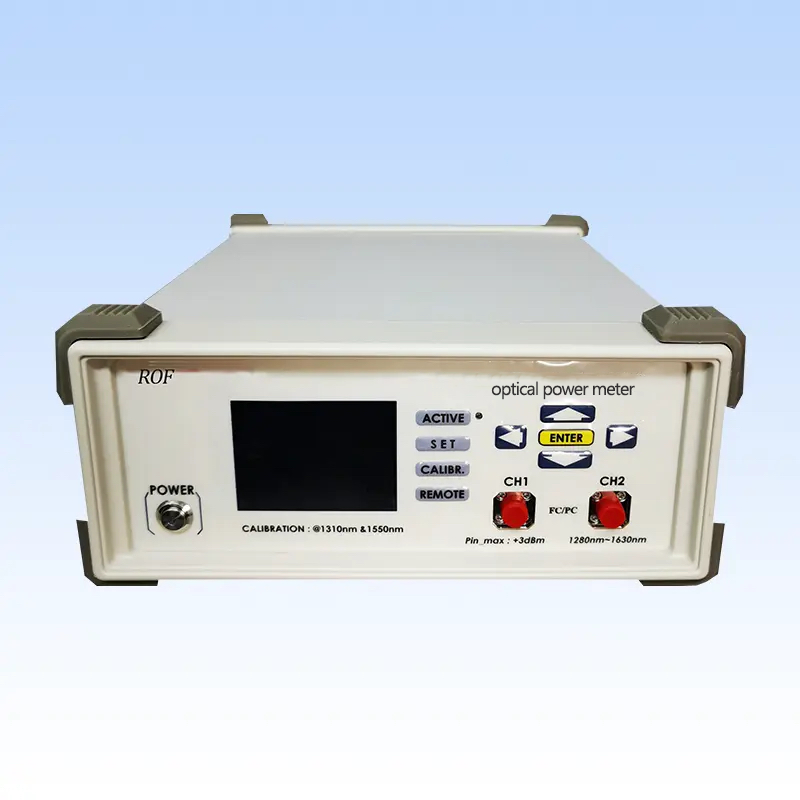Optical fiber spectrometers usually use optical fiber as a signal coupler, which will be photometric coupled to the spectrometer for spectral analysis. Due to the convenience of optical fiber, users can be very flexible to build a spectrum acquisition system.
The advantage of fiber optic spectrometers is the modularity and flexibility of the measurement system. The micro optical fiber spectrometer from MUT in Germany is so fast that it can be used for online analysis. And because of the use of low-cost universal detectors, the cost of the spectrometer is reduced, and thus the cost of the entire measurement system is reduced
The basic configuration of the fiber optic spectrometer consists of a grating, a slit, and a detector. The parameters of these components must be specified when purchasing a spectrometer. The performance of the spectrometer depends on the precise combination and calibration of these components, after calibration of the optical fiber spectrometer, in principle, these accessories can not have any changes.
Function introduction
grating
The choice of grating depends on the spectral range and resolution requirements. For fiber optic spectrometers, the spectral range is usually between 200nm and 2500nm. Due to the requirement of relatively high resolution, it is difficult to obtain a wide spectral range; At the same time, the higher the resolution requirement, the less luminous flux. For the requirements of lower resolution and wider spectral range, 300 line /mm grating is the usual choice. If a relatively high spectral resolution is required, it can be achieved by choosing a grating with 3600 lines /mm, or choosing a detector with more pixel resolution.
slit
The narrower slit can improve the resolution, but the light flux is smaller; On the other hand, wider slits can increase sensitivity, but at the expense of resolution. In different application requirements, the appropriate slit width is selected to optimize the overall test result.
probe
The detector in some ways determines the resolution and sensitivity of the fiber optic spectrometer, the light sensitive region on the detector is in principle limited, it is divided into many small pixels for high resolution or divided into fewer but larger pixels for high sensitivity. Generally, the sensitivity of the CCD detector is better, so you can obtain a better resolution without sensitivity to some extent. Because of the high sensitivity and thermal noise of InGaAs detector in near infrared, the signal-to-noise ratio of the system can be effectively improved by means of refrigeration.
Optical filter
Because of the multistage diffraction effect of the spectrum itself, the interference of multistage diffraction can be reduced by using the filter. Unlike conventional spectrometers, fiber optic spectrometers are coated on the detector, and this part of the function needs to be installed in place at the factory. At the same time, the coating also has the function of anti-reflection and improves the signal-to-noise ratio of the system.
The performance of the spectrometer is mainly determined by the spectral range, optical resolution and sensitivity. A change to one of these parameters will usually affect the performance of the other parameters.
The main challenge of the spectrometer is not to maximize all the parameters at the time of manufacture, but to make the technical indicators of the spectrometer meet the performance requirements for different applications in this three-dimensional space selection. This strategy enables the spectrometer to satisfy customers for maximum return with minimum investment. The size of the cube depends on the technical indicators that the spectrometer needs to achieve, and its size is related to the complexity of the spectrometer and the price of the spectrometer product. Spectrometer products should fully meet the technical parameters required by customers.
Spectral range
Spectrometers with a smaller spectral range usually give detailed spectral information, whereas large spectral ranges have a wider visual range. Therefore, the spectral range of the spectrometer is one of the important parameters that must be clearly specified.
The factors that affect the spectral range are mainly grating and detector, and the corresponding grating and detector are selected according to different requirements.
sensitivity
Speaking of sensitivity, it is important to distinguish between sensitivity in photometry (the smallest signal strength that a spectrometer can detect) and sensitivity in stoichiometry (the smallest difference in absorption that a spectrometer can measure).
a. Photometric sensitivity
For applications that require high sensitivity spectrometers, such as fluorescence and Raman, we recommend SEK thermo-cooled optical fiber spectrometers with thermo-cooled 1024 pixel two-dimensional array CCD detectors, as well as detector condensing lenses, gold mirrors, and wide slits (100μm or wider). This model can use long integration times (from 7 milliseconds to 15 minutes) to improve signal strength, and can reduce noise and improve dynamic range.
b. Stoichiometric sensitivity
In order to detect two values of absorption rate with very close amplitude, not only the sensitivity of the detector is required, but also the signal-to-noise ratio is required. The detector with the highest signal-to-noise ratio is the thermoelectric refrigerated 1024-pixel two-dimensional array CCD detector in the SEK spectrometer with a signal-to-noise ratio of 1000:1. The average of multiple spectral images can also improve the signal-to-noise ratio, and the increase of the average number will cause the signal-to-noise ratio to increase at the square root speed, for example, the average of 100 times can increase the signal-to-noise ratio 10 times, reaching 10,000:1.
Resolution
Optical resolution is an important parameter to measure the optical splitting ability. If you need very high optical resolution, we recommend that you choose a grating with 1200 lines/mm or more, along with a narrow slit and a 2048 or 3648 pixel CCD detector.
Post time: Jul-27-2023






